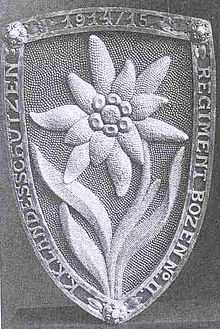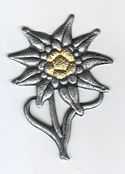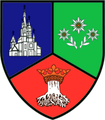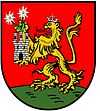Leontopodium alpinum
| Edelweiss | |
|---|---|
| | |
| Scientific classification | |
| Kingdom: | Plantae |
| (unranked): | Angiosperms |
| (unranked): | Eudicots |
| (unranked): | Asterids |
| Order: | Asterales |
| Family: | Asteraceae |
| Tribe: | Gnaphalieae[1] |
| Genus: | Leontopodium |
| Species: | L. alpinum |
| Binomial name | |
| Leontopodium alpinum Cass., 1822 | |
Leontopodium alpinum, usually called edelweiss (English pronunciation ![]() i/ˈeɪdəlvaɪs/, from German [ˈeːdəlvaɪs]), is a well-known mountain flower, belonging to the Asteraceae (the daisy or sunflower family).
i/ˈeɪdəlvaɪs/, from German [ˈeːdəlvaɪs]), is a well-known mountain flower, belonging to the Asteraceae (the daisy or sunflower family).
The plant is unequally distributed and prefers rocky limestone places at about 1800–3000 m altitude. It is non toxic, and has been used traditionally in folk medicine as a remedy against abdominal and respiratory diseases. The dense hair appears to be an adaptation to high altitudes, protecting the plant from cold, aridity and ultraviolet radiation.[2] As a scarce short-lived flower found in remote mountain areas, the plant has been used as a symbol for alpinism, for rugged beauty and purity associated with the Alps, and as a national symbol especially of Austria and of Switzerland. There is a folklore associated with the edelweiss in which it is stated that giving this flower as a gift to a loved one is a promise of dedication.
Names
The common name is from the German, in standard spelling Edelweiß (with the Eszett (ß) letter), literally translating to "noble-white", a compound of the adjectives edel "noble" and weiß "white" (spelled Edelweiss, weiss in Switzerland).[3] As an adjective, edelweiss is also used in oenology of wine from the Gutedel (Chasselas) grape.
The name edelweiss originates as one of numerous regional appellations, and entered wide use during the first half of the 19th century, in the context of early Alpine tourism and the exploration of the High Alps.[4]
Alternative regional Swiss German names of the flower include Chatzen-Talpen ("cat's paws"), and older wullbluomen ("wool-flower", attested in the 16th century[5]).[6]
The scientific name Leontopodium is a Latin adaptation of Greek leontopódion (λεοντοπόδιον) "lion's paw".[7] The first scientific name for Leontopodium alpinum which was validly published according to the current binomial nomenclature is Gnaphalium alpinum in the first edition (1753) of Linnaeus's Species Plantarum.
Since 1822 (Cassini) Leontopodium has no longer been considered part of the Gnaphalium genus, but classified alongside it as a distinct genus within the Gnaphalieae tribe. In 2003, Leontopodium alpinum was re-classified as a subspecies of Leontopodium nivale. Thus, the alpine edelweiss is currently recognized as being divided into two subspecies, Leontopodium nivale subsp. alpinum (Cass.) Greuter and Leontopodium nivale subsp. nivale.
Description
Leaves and flowers are covered with white hairs and appear woolly (tomentose). Flowering stalks of edelweiss can grow to a size of 3–20 cm (1–8 in) in the wild, or, up to 40 cm (16 in) in cultivation. Each bloom consists of five to six small yellow clustered spikelet-florets (5 mm, 3⁄16 in) surrounded by fuzzy white "petals" (technically, bracts) in a double star formation. The flowers bloom between July and September.
-

Early-season version with central floret-pods not yet fully developed. Specimen found in Slovakia's Tatra Mountains.
-

Typical mid-season appearance. Specimen found in Italy's Bergamo Alps.
-

Late season version with "fat" appearance from flowered-out central floret-pods and from longer petal-"fuzz".[1] Specimen found in the Stubai Alps.[2]
-

Botanic illustration.
- ^ NOTE: Sometimes mistaken for a different species (reference only).
- ^ NOTE: Image courtesy of Bernd Haynold (reference only).
Protection
Leontopodium sp. is a protected plant in many countries, including Mongolia, Bulgaria, Croatia, Switzerland (since 1878), France, Norway, Iran, India (Zanskar region), Italy, Serbia, Malaysia (In Genting and Cameron Highlands), Indonesia (In Semeru Mountain), Germany, Spain (Ordesa National Park), Poland and Slovakia (Tatra National Park), Slovenia (in Gorizia and Gradisca since 1896, in Carniola since 1898), Austria (since 1886) and Romania (since 1933).
Cultivation
Leontopodium alpinum is grown in gardens for its interesting inflorescence and silver foliage.[8] The plants are short lived and can be grown from seed.[9]
Symbolic uses
%2C_chromolithograph_by_Helga_von_Cramm%2C_with_hymn_by_F._R._Havergal%2C_1877.jpg)
The edelweiss in the 19th century became a symbol of the rugged purity of the High Alps and of the supposedly similar qualities of the native population of the Alpine region. The edelweiss became current as such a symbol in German literature and poetry of the first half of the 19th century, and soon also in the romantic nationalism of the time, in Austria, Switzerland, Tyrol, and Bavaria.
Berthold Auerbach published a novel entitled Edelweiss in 1861, where the difficulty for an alpinist to acquire an edelweiss flower was exaggerated to the point of claiming that "the possession of one is a proof of unusual daring".[10] This idea at the time was becoming part of the popular mythology of early alpinism.[11] Auerbach's novel appeared in English translation in 1869, prefaced with a quote attributed to Ralph Waldo Emerson,
- "There is a flower known to botanists, one of the same genus with our summer plant called 'Life-Everlasting', a Gnaphalium like that, which grows on the most inaccessible cliffs of the Tyrolese mountains, where the chamois dare hardly venture, and which the hunter, tempted by its beauty and by his love (for it is immensely valued by the Swiss maidens), climbs the cliffs to gather, and is sometimes found dead at the foot, with the flower in his hand. It is called by botanists the Gnaphalium leontopodium, but by the Swiss EDELWEISS, which signifies NOBLE PURITY."
- Before 1914
- in the military ranks of the Swiss Armed Forces since the mid 19th century and to the present day, the highest ranks (brigadier general and higher) have badges where edelweiss flowers take the place where other militaries place stars.
- The edelweiss was established 1907 as the sign of the Austrian-Hungarian alpine troops by Emperor Franz Joseph I. These original 3 Regiments wore their edelweiss on the collar of their uniform. During World War I (1915) the edelweiss was granted to the German alpine troops, for their bravery. Today it is still the insignia of the Austrian, Polish, Romanian, and German alpine troops.
- World Wars era
- The song Es War Ein Edelweiss was written by Herms Niel for soldiers during World War II
- Edelweiss was a badge of Edelweiss Pirates (Edelweisspiraten)—the anti-Nazi youth groups in Third Reich. It was worn on the clothes (e.g. a blouse or a suit).
- The edelweiss flower was the symbol of Wehrmacht and Waffen-SS Gebirgsjäger, or mountain rangers, worn as a metal pin on the left side of the mountain cap, on the band of the service dress cap, and as a patch on the right sleeve. It is still the symbol of the Mountain brigade in the German army today.
- The World War II Luftwaffe unit, Kampfgeschwader 51 (51st Bomber Wing) was known as the Edelweiss Wing.
- The edelweiss is represented as the favorite flower of Adolf Hitler, in the 1934 recording "Adolf Hitlers Lieblingsblume ist das schlichte Edelweiß", sung by Harry Steier.[12]
- After 1945
- The edelweiss flower is a common symbol worn by today's United States Army's 1st Battalion 10th Special Forces Group Airborne Soldiers. The 1-10th SFG(A) Soldiers adopted the symbol under the command of (Ret.) Col. Aaron Banks after they occupied the former Waffen SS officer school (Junkerschule) at Flint Kaserne.
- The song "Edelweiss", which is about the flower, is from Rodgers and Hammerstein's 1959 musical The Sound of Music, which takes place in Salzburg, Austria before World War II.
- On the Austrian two-euro-cent coin (since 2002), a picture of edelweiss is used.
- On the Austrian one-schilling coin (1959 - 2001) is a bunch of 3 flowers
- It is the symbol of the Bulgarian Tourist Union and the Bulgarian Mountain Control and Lifeguard Service (PKSS).
- It is also the symbol of the Swiss national tourism organisation
- On the Romanian 50 Lei banknote.
- In Austria, Edelweiß is also a brand of beer named after the flower.
- The edelweiss is used in the logotypes of several alpine clubs such as the Deutscher Alpenverein (German Alpine Club) or the Österreichischer Alpenverein (Austrian Alpine Club). The edelweiss is also used in the logotype of the Union of International Mountain Leader Associations (UIMLA).
- In Asterix in Switzerland (1970), the sixteenth book of the Asterix series by Goscinny and Uderzo, the narrative is driven by a quest to find edelweiss in the Swiss mountains and bring a bloom back to Gaul to cure a poisoned Roman quaestor.
- Edelweiss Air, an international airline based in Switzerland, is named after the flower, which also appears in its logo.
- "Bring me Edelweiss" is the best-known song of the music group Edelweiss.
- Polish professional ice hockey team MMKS Podhale Nowy Targ use an edelweiss as their emblem.
- Edelweiss Lodge and Resort is a military resort located in Garmisch, Germany.
Symbolic use, image gallery
- Some symbolic use from ancient times to the present
-

On the 2 cent Austrian euro coin.
-

World War One-era nail-fundraiser monument: the Iron Edelweiss of Enns, Austria.
-

Nazi German cap badge insignia for Wehrmacht Gebirgsjäger (mountain troops).
-

1963 German mountain sport pin.
-

German Alpine Club logo pin.[1]
-

On a Romanian 50 lei banknote.
-

Logo of the Union of International Mountain Leader Associations.
-
.jpg)
Nazi-era nose art on a bomber from the "Edelweiss Wing" (KG 51).
-

Nazi-era photo with KG 51 insignia on a Ju 88 bomber.
-

1939 Nazi-era aircraft nose art.
-
French mountain troops school emblem.[2]
-

Logo of German sports association RMSV.
-

Rank insignia in the Swiss postal service.
-
German Federal Police rank insignia patch.
-

Kyrgyz postage stamp from 1994.
-

West German postage stamp from 1975.
-

Logo of Edelweiss tour bus lines.
-

On 2004 Swiss coin.
-

On 1925 gold 100 Swiss francs coin.
-

On 1983 Austrian 1 schilling coin.
-

Kazakhstan 500 тенге coin.
-

Four-"Star" rank insignia of the top Swiss general.
-

Austrian army JgB 23 emblem.
-

West/German military "Allgäu" fighter/bomber group 1958-2003.
-
.svg.png)
West/German military 23rd mountain rifles troops emblem.
-

Polish military 21. Batalionu Strzelców Podhalańskich (Szarotka) emblem.
-

Russian military 17 ОСН "Edelweiss" emblem.
-

Austrian army JgB 6 emblem.
-

Coat of arms of Vaujany in France.
-

Coat of arms of Au in Austria.
-

Coat of arms of Brașov County in Romania.
-

Coat of arms of Dramsha in Bulgaria.
-
.svg.png)
Coat of arms of Bonnefamille in France.
-
.svg.png)
Coat of arms of Chamonix-Mont-Blanc in France.
-

Coat of arms of Carroz d'Arâches in France.
-

Coat of arms of Eisenärzt in Germany.
-

Logo of Edelweiss Beer.
-

General's "star" on the saddle of WWI-era Swiss commander Ulrich Wille.
-

On the hat and collar circa 1933 of Austria's Engelbert Dollfuss.
-

Imperial Roman tombstone of Austrian soldier Marius son of Ructinus.
- ^ NOTE: DAV on this pin means Deutscher Alpenverein not Disabled American Veterans for which such pins may be confused (reference only).
- ^ NOTE: CIECM meaning Centre d' Instruction et d' Entraînement au Combat en Montagne (reference only).
| Wikimedia Commons has media related to Edelweiss in art. |
See also
References
- ↑ Randall J. Bayer, Christopher F. Puttock, and Scot A. Kelchner (2000). "Phylogeny of South African Gnaphalieae (Asteraceae) based on two noncoding chloroplast sequences". American Journal of Botany 87 (2): 259–272. doi:10.2307/2656914. JSTOR 2656914. PMID 10675314.
- ↑ Vigneron, Jean Pol; Marie Rassart; Zofia Vértesy; Krisztián Kertész; Michaël Sarrazin; László P. Biró; Damien Ertz; Virginie Lousse (January 2005). "Optical structure and function of the white filamentary hair covering the edelweiss bracts". Physical Review E (American Physical Society) 71. arXiv:0710.2695.
- ↑ William Shepard Walsh (1909). Handy-book of literary curiosities. J.B. Lippincott Co. pp. 268–. Retrieved 19 August 2010.
- ↑ Edelweiss reported as common name alongside Alpen-Ruhrkraut in Kittel, Taschenbuch der Flora Deutschlands zum bequemen Gebrauch auf botanischen Excursionen (1837), p. 383.
- ↑ Aretius, Stocc-Hornii et Nessi [...] descriptio [...], a Benedicto Aretio [...] dictata., published with Valerii Cordi Simesusii Annotationes in Pedacii Dioscoridis Anazarbei de medica materia libros V, Basel (1561), ed. Bratschi (1992) in Niesen und Stockhorn. Berg-Besteigungen im 16. Jahrhunder.
- ↑ Schweizerisches Idiotikon 16.1997.
- ↑ λέων, πόδιον, πούς. Liddell, Henry George; Scott, Robert; A Greek–English Lexicon at the Perseus Project
- ↑ Mineo, Baldassare (1999). Rock garden plants: a color encyclopedia. Portland, Or.: Timber Press. p. 150. ISBN 0-88192-432-6.
- ↑ McVicar, Jekka. Seeds: The Ultimate Guide to Growing Successfully from Seed. The Lyons Press. p. 22. ISBN 1-58574-874-9.
- ↑ Auerbach (1869), http://books.google.ch/books?id=4zcoAAAAYAAJ&pg=PA77 p. 77]
- ↑ c.f. "chamois hunting" in New monthly magazine and universal register (1853) p. 166
- ↑ http://forum.axishistory.com/viewtopic.php?p=1180704#p1180704
External links
| Wikimedia Commons has media related to Leontopodium alpinum. |


